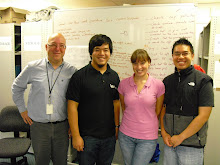Just a few weeks ago I found an old Canvas magazine from the New Zealand Herald and the cover story was called, ‘Where Science Meets Art’. Of course this grabbed my attention so I pored over the article. In Auckland a month or so ago, there was an exhibition showcasing artworks that were the result of a collaboration between artists and scientists. 15 artists were paired with 15 neuroscientists and were instructed to create artworks based on their interpretations of various kinds of brain research. The exhibition was called, ‘Do You Mind?’ and you can view the organiser’s blog
here.

It is very exciting to me that while I continue with my interaction and collaboration, there are similar efforts out there in Auckland to bring together the two industries. The goals of our two projects are the same. Both efforts want to bring artwork to the public to raise the profile of the area of scientific research. We have been allowed into a world that the ordinary person has no access to and would most likely never gain access to. We can toil and struggle in the lab. We can discover these new things and report back to the public with our findings in a way that the scientific community doesn’t.
A major difference in our projects is that the artists from, ‘Do You Mind?’ only witnessed the research and interacted with the neuroscientists. In my project I am actively using the very same technology, materials and processes that the scientists use. The technology is my artwork. I am making the science a part of the final visual experience, rather than doing a drawing or a painting of my interpretation of the research. However, the end result is still the same. Our audience has become aware of another part of our world that we had not entered before.
The artists in the neuroscience project describe the separation of the art world and the science world. For most artists this is a fact. Art and science do not collide. Visual artists generally gravitate towards a way of expression like painting, sculpture, performance art or video art. These types of artistic expression are not experimented with in a lab. Scientists usually do not express their ideas in a visual interpretation. They may map out 2D and 3D imagery to see how something could work or take measurements of weight and force etc but their efforts are geared towards answers and fact based on experimentation, not subjective expression.
I am drawn to the obvious example of Leonardo da Vinci who had many skills and was talented in a number of fields. He was not only a master painter but an inventor, engineer, geologist and anatomist. Da Vinci is merely one man of many of his time who were more than capable of artistic pursuits as well as scientific ones. Not only was he a thinker in both fields, but he could combine his talents for one goal. For example, all of his knowledge of the anatomy, space and perspective combined to create perfect paintings.
Since Leonardo’s time until recently, the gap between art and science has widened. People have become masters of only one field, not many. With my project, and the recent project with the brain research, this gap is becoming smaller. It’s an exciting time.









